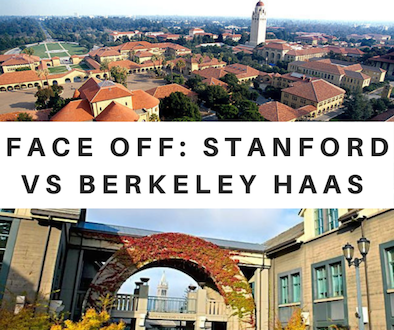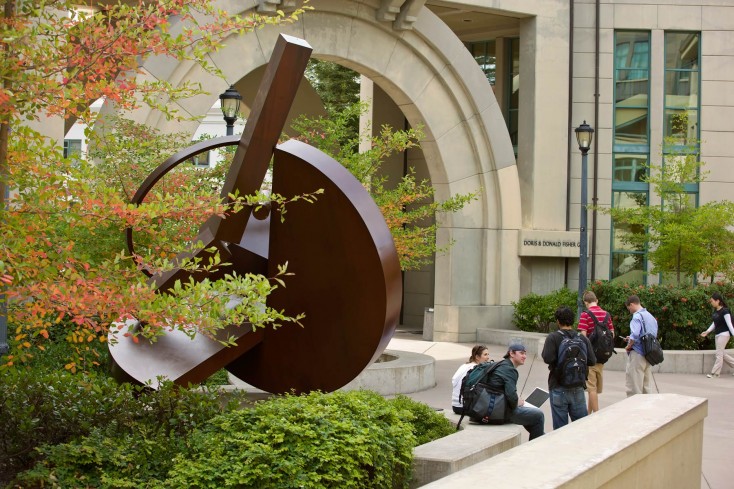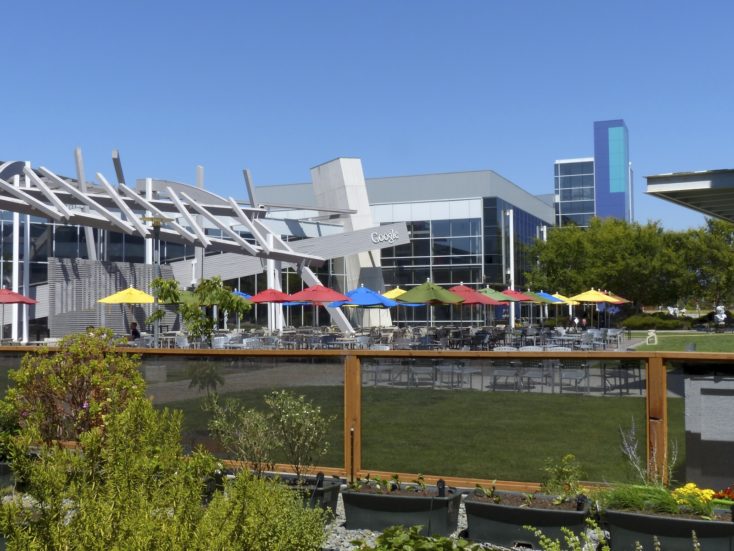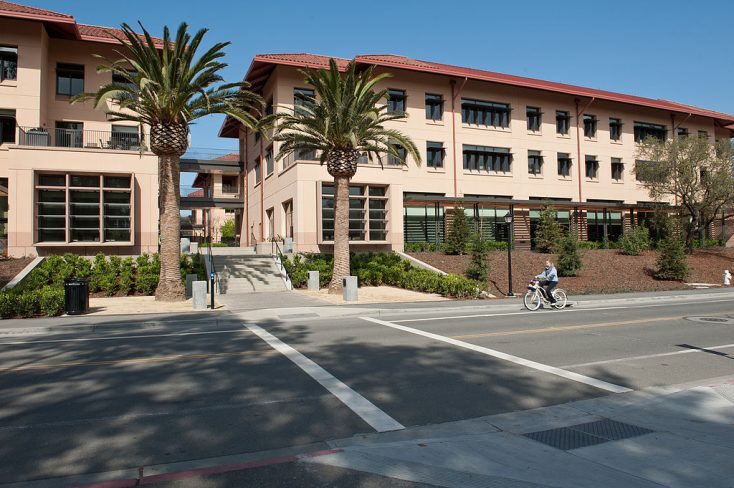-
Target Test Prep's 2024 GMAT Focus Edition prep is discounted for the BTG community!
Redeem
Face Off: Stanford GSB vs Berkeley Haas

The school selection process for MBA applicants can seem overwhelming. With so many great business schools, how do you decide which one is right for you? In SBCs new blog seriesFace Off, we tease out the strengths and differences between two similarly ranked b-schools. Plus, well highlight noteworthy elements of their admissions processes. First item of business today: the Stanford MBA application versus the UC Berkeley Haas MBA application.
How do the admissions requirements and selectivity compare between the pair?
The Stanford Graduate School of Business is more selective and has the lowest acceptance rate of any MBA program. Their admissions requirements are comparable, with test scores, competitive GPA, rec letters and essays expected by both. Regarding essays, the Stanford MBA application prompts have remained the same for years: What matters most to you, and why? and Why Stanford?
In contrast to the Stanford MBA application, the essay questions at UC Berkeley Haas School of Business have historically focused on personality and moments. For example, last season, one Haas application essay prompt was, Tell us a six-word story that reflects a memorable experience in your life-to-date. Elaborate on why it is meaningful to you."
[caption id="attachment_27524" align="alignnone" width="734"] UC Berkeley Haas School of Business[/caption]
UC Berkeley Haas School of Business[/caption]
Previous application essay prompts for Haas were equally creative. Some years, Haas would ask about a favorite song. When asked about their favorite song essay submission, one member cited, 'Always Be My Baby' by Mariah Carey---a football player described how he used it to pump him up before each game in the locker room. Another mentioned a very personal story about a song the candidate wrote for his fiance, shares a former Haas Admissions Officer at Stacy Blackman Consulting.
How do the quality of the MBA cohorts compare, and what about the culture?
Both programs are known to be collaborative, with self-aware, well-rounded and inspired student culture, says Stacy Blackman. Neither program is known for a hyper-competitive vibe, the way HBS or Wharton have been characterized.
I advise applicants to draw their own conclusions. I ask clients to visit the schools or engage virtually to get a sense of whether one would fit in, shares a former GSB Admissions Officer on the Stacy Blackman Consulting team.
"With lower acceptance rates and greater selectively, its likely GSBs student culture and population allows for deeper intellectual exploration," Blackman adds.
What are the advantages of being based in Silicon Valley?

Advantages:
It is no secret that the location of both Haas and GSB is ideal for goals in the technology arena. Studying in the center of Silicon Valley provide access to industry lecturers, case studies, team projects for local companies, on-site company visits and more. Silicon Valley is home to technologists, innovators, life science visionaries, and venture capitalists. The location can facilitate finding the right job for technology talents and interests.
Caveats:
Functions within the tech universe, such as entrepreneurship and venture capital, are more associated with brand/prestige of the MBA program than Silicon Valley itself. Haass employment reports lack data on entrepreneurs and venture capital placement specifically.
Our clients would usually favor HBS, GSB, and Wharton (over Haas) for the arenas of entrepreneurship and venture capital. By contrast, GSB does report graduates into both entrepreneurship and venture capital, as we would predict because of its stronger brand.
More than tech
At the same time, These career paths arent the only ambitions that Haas and GSB empower. For example, the Bay Area is a prime location for students aspiring toward international business. California serves as a gateway to South American and Asian economies, with many of the world's global companies headquartered in the Bay Area, says Blackman.
Because Stanford is a private institution and Haas is not, does Stanford have more resources to dedicate to teaching, facilities, etc?
[caption id="attachment_32756" align="alignnone" width="734"] Stanford Graduate School of Business[/caption]
Stanford Graduate School of Business[/caption]
Stanford has far more resources, and it shows through its facilities, faculty caliber, etc. GSB also has less distractions, as it only has the two-year, full-time MBA program. Haas has part-time and EMBA programs, and it encompasses the undergraduates that are part of the Haas School.
The GSB also has more faculty, approx 100, whereas Haas has around 80. These numbers are possibly higher at GSB because of the exclusive focus on its full-time, two-year MBA Program. Stanfords MsX program (non-MBA) is a recent addition however; but its a small program.
For a deeper dive into the teaching methods and curricula at both schools, check out this article from Poets & Quants.
What are the key differences that prospective MBA students should consider?
Career aspirations should be a key factor in deciding which program to pursue. A former Haas Admissions Officer on the Stacy Blackman team shared, GSB is more entrepreneurial-focused. GSB is better recognized than Haas for its graduates who have become successful tech leaders and entrepreneurs. GSB is oriented more to the start-up, entrepreneurial focus. Haas has more graduates going into more traditional post-MBA roles (consulting, product management, finance).
How do the career outcomes between the schools stack up?
There is a perception that they are both tech or entrepreneurial schools. Career placement data for both schools shows tech dominance, but there is also a very recent decrease in tech placement. Tech recruiting trends can be seen via Haas and GSBs employment reports.
The tech representation for Haas graduates has decreased to around 37%, which is still much higher than even MIT Sloans placement into tech over the years (which hovers closely around 30%) and is roughly double the placement of HBS graduates into tech industry.
Similarly, GSBs placement into the tech industry was consistently been between 30 and 35% for the years between 2012 and 2016, with the peak placement of 35% for the class of 2015.
Like Haas, the most recent report for GSB shows a relative decrease recently; GSB is at around 25% placement into the tech industry as shown in its 2016-2017 employment report. That 25% is still much higher than HBS, Wharton etc., but overshadowed by MIT and Haass placement stats in technology for the same period.
Final notes on each program
The Haas School is known for its diverse and talented faculty, staff, students and alumni. They have created an innovative academic culture that stresses cooperative teamwork, entrepreneurship, a global point of view, and an emphasis on new ideas and fresh perspectives. TRANSFORMATION was a theme of the Adcom. The program focuses on developing Berkeley leaders. Haas believes in helping people find meaningful work.
Unlike some other programs, Stanfords GSB never publicly releases grades, keeping them a private matter between students and faculty members. The GSB offers a highly customized program. After a shared experience in the first quarter, students no longer have specific required courses, but select courses to meet their own set of distribution requirements. With the help of a faculty adviser, each GSB student creates a study plan to challenge and push themselves, tailored to their past experience level.
We hope this deep-dive comparison between the Stanford MBA application and Haas application has given you helpful intel as you make your school selection decisions this season. tuned for more Face Off posts to come.
Recent Articles
Archive
- June 2024
- May 2024
- April 2024
- March 2024
- February 2024
- January 2024
- December 2023
- November 2023
- October 2023
- September 2023
- July 2023
- June 2023
- May 2023
- April 2023
- March 2023
- February 2023
- January 2023
- December 2022
- November 2022
- October 2022
- September 2022
- August 2022
- July 2022
- June 2022
- May 2022
- April 2022
- March 2022
- February 2022
- January 2022
- December 2021
- November 2021
- October 2021
- September 2021
- August 2021
- July 2021
- June 2021
- May 2021
- April 2021
- March 2021
- February 2021
- January 2021
- December 2020
- November 2020
- October 2020
- September 2020
- August 2020
- July 2020
- June 2020
- May 2020
- April 2020
- March 2020
- February 2020
- January 2020
- December 2019
- November 2019
- October 2019
- September 2019
- August 2019
- July 2019
- June 2019
- May 2019
- April 2019
- March 2019
- February 2019
- January 2019
- December 2018
- November 2018
- October 2018
- September 2018
- August 2018
- July 2018
- June 2018
- May 2018
- April 2018
- March 2018
- February 2018
- January 2018
- December 2017
- November 2017
- October 2017
- September 2017
- August 2017
- July 2017
- June 2017
- May 2017
- April 2017
- March 2017
- February 2017
- January 2017
- December 2016
- November 2016
- October 2016
- September 2016
- August 2016
- July 2016
- June 2016
- May 2016
- April 2016
- March 2016
- February 2016
- January 2016
- December 2015
- November 2015
- October 2015
- September 2015
- August 2015
- July 2015
- June 2015
- May 2015
- April 2015
- March 2015
- February 2015
- January 2015
- December 2014
- November 2014
- October 2014
- September 2014
- August 2014
- July 2014
- June 2014
- May 2014
- April 2014
- March 2014
- February 2014
- January 2014
- December 2013
- November 2013
- October 2013
- September 2013
- August 2013
- July 2013
- June 2013
- May 2013
- April 2013
- March 2013
- February 2013
- January 2013
- December 2012
- November 2012
- October 2012
- September 2012
- August 2012
- July 2012
- June 2012
- May 2012
- April 2012
- March 2012
- February 2012
- January 2012
- December 2011
- November 2011
- October 2011
- September 2011
- August 2011
- July 2011
- June 2011
- May 2011
- April 2011
- March 2011
- February 2011
- January 2011
- December 2010
- November 2010
- October 2010
- September 2010
- August 2010
- July 2010
- June 2010
- May 2010
- April 2010
- March 2010
- February 2010
- January 2010
- December 2009
- November 2009
- October 2009
- September 2009
- August 2009